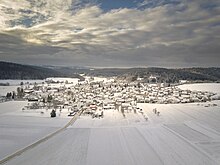Holy rooms
|
Holy rooms
City of Rosenfeld
|
|
|---|---|
| Coordinates: 48 ° 19 ′ 51 ″ N , 8 ° 43 ′ 43 ″ E | |
| Height : | 487 m |
| Area : | 6.96 km² |
| Residents : | 893 (Jan. 1, 2016) |
| Population density : | 128 inhabitants / km² |
| Incorporation : | 1st January 1975 |
| Postal code : | 72348 |
| Area code : | 07428 |
|
Heiligenzimmer on the Stunzach - view from the north
|
|
Heiligenzimmer is a district of Rosenfeld in the Zollernalb district . The village has 893 inhabitants and is located near the federal highway 81 between Stuttgart and Lake Constance in the Stunzachtal.
facts and figures
The district of Heiligenzimmer (500 m NN - Fl: 6.96 km²) is the only community in the old district of Hechingen that has merged with communities in the old district of Balingen as part of the community reform . The place name in the Middle Ages was "Zimmer in Horgun" or "Horgenzimmer" and indicates the location of the settlement in the lowlands of the Stunzach valley (horgen = swampy).
In the 13th and 14th centuries, the Knights of Zimmer, who had their castle west of the village above the Burghalde, named themselves after the place. Below was the Fronhof , which belonged to the Reichenau monastery . The successor to Reichenau in the 13th century was the nearby Kirchberg Monastery , to which almost all of the property in Heiligenzimmer belonged until it was abolished in 1805. The sovereignty over the place lay with the rule Haigerloch , whose history Heiligenzimmer shares. In 1836 the village had 456 and 1890 450 inhabitants, in 2003 900 inhabitants.
The mayor has been Klaus May since 2019.
History of the place
The place name developed from Zimbern in horgun, Zimbern in horgenorve, that is rooms in swampy, wet lowlands, over Horgenzimmer, Holgenzimmer to holy rooms. The place name has nothing to do with "holy". The settlement was first mentioned in a consecration document, which was found in the altar of the old parish church in 1847 and was issued by Bishop Eberhard I , who ruled the Diocese of Constance from 1034 to 1046.
In 1275 the parish is listed in the well-known Liber decimationis , a tax list for the crusade. Politically, Heiligenzimmer has always belonged to the Haigerloch rule and ecclesiastically to the dean's office Haigerloch-Empfingen. In the High Middle Ages, almost the entire place was owned by the baronial Reichenau Monastery .
In 1273 the abbot of the Reichenau monastery confirmed Count Hermann von Sulz's renunciation of the manor, the Fronhof , with which the patronage right was connected, in favor of the Kirchberg monastery . In the course of the 14th century, the monastery brought almost the entire village into its possession through donations and purchases. He also owned the grinding and sawmill and the large fish pond south of today's cemetery. The Fronhof was issued as an inheritance , initially to two, later to three and in the 18th century to four feudal farmers. In 1789 Kirchberg sold the inheritance justice of the Fronhof to the four owners, who thereby became owners. When the monastery was abolished in 1806, its ownership fell to the Württemberg state, from which the municipality was able to buy back the fields but not the forests in the district.
In the Middle Ages, the village also had a hermitage, i.e. a settlement where virgins and widows lived a semi-monastic life without fixed rules. They dedicated themselves especially to the works of mercy and Christian charity, the care of the sick and the education of the young. When the building fell victim to a conflagration in 1554, the sisters moved to Gruol , whose hermitage was elevated to a formal Dominican convent with a prioress in 1577 . Until the first half of the 18th century, the nearby Bernstein Monastery also belonged to the parish of Heiligenzimmer as a branch. The brothers had their pews in the village church and they found their final resting place in the village cemetery. The brothers built new buildings with their own church from 1729 to 1731. However, they remained ecclesiastically parish to Heiligenzimmer until the secularization .
On January 1, 1975, Heiligenzimmer was incorporated into the city of Rosenfeld.
Attractions

- St. Patrizius Church in Gothic style
- Monastery mill
- Kirchberg Monastery
- Franciscan Terziarenkloster Bernstein
- Jäckle grave between Heiligenzimmer and Bergfelden
- Wendelinus Chapel
- Historic bakery
Sons and daughters
- Joseph Pfeffer (1879–1960), Mayor of Lörrach
Individual evidence
- ↑ Maximilian Schaitel in "Black Bote" Z 119 27-28. May 1967
- ^ Federal Statistical Office (ed.): Historical municipality directory for the Federal Republic of Germany. Name, border and key number changes in municipalities, counties and administrative districts from May 27, 1970 to December 31, 1982 . W. Kohlhammer, Stuttgart / Mainz 1983, ISBN 3-17-003263-1 , p. 541 .



